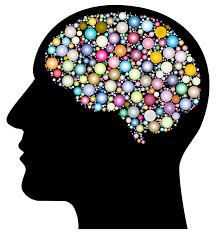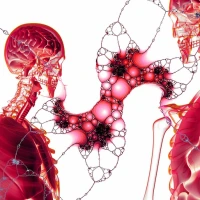In this lesson, we explore the nervous system and share notes as part of the study guide series. We will explore the awesome brain and nerves! Topics include structure of the nervous system, function, the motor unit, peripheral somatosensation, and muscle stretch reflex.
Structure of the Nervous System
- Central Nervous System is made of brain and spinal cord
- Brain can be divided into:
- cerebrum — the top and the biggest part of the brain;
it has two distinct left and right hemispheres
- brain stem — hooks onto the spinal cord, is itself
divided into midbrain (top), Pons (middle), and
Medulla (bottom, also called medulla oblongata; this
connects to the spinal cord)
- cerebellum — sits behind the brain stem and is
connected to it
- cerebrum — the top and the biggest part of the brain;
- Brain structures are sometimes referred to by what they developed from in the embryo:
- forebrain (aka prosencephalon) — becomes cerebrum (temporal lobe, frontal lobe, occipital lobe, parietal lobse)
- midbrain (aka mesencephalon) — becomes midbrain (top of the brain stem), substantia niagra
- hindbrain (aka rhombencephalon) — becomes the rest of the brain – pons, medulla, cerebellum
- Brain can be divided into:
- Peripheral Nervous System is made of nerves and ganglia
- Nerves carry the axons of neurons, while ganglia are lumps attached to nerves that contain the somas of neurons
- Afferent neurons carry information into the central nervous system
- Efferent neurons carry information away from the central nervous system to the periphery.
- An impulse moving through a neuron that carries info from PNS —> CNS is an afferent neuron impulse moving proximally
- Nerves can be divided into different categories (and are in pairs on each side of the body):
- Cranial Nerves — exit the skull, primarily coming out of the brain and pass through the skull on the way between the central and periphery nervous system. (12 pairs)
- Spinal Nerves — come out of the spinal cord and pass through the spine on their way between the central and peripheral nervous systems. (23 pairs)
- Spinal nerves form from spinal nerve roots.
- Efferent neurons (carrying info away) go through spinal nerve root in the front while afferent neurons (carrying into in) go through spinal nerve roots in the back.
- These come together in the spinal nerves, which we call mixed nerves.
- As any of the nerves travel from their proximal (close to center of the body) to their distal ends, they branch repeatedly, getting smaller and smaller.

Functions of the Nervous System
- Can be divided into basic (lower) functions and higher (complex) functions
- Patterns of abnormal functions are called syndromes. Some syndromes are more common than others because they’re caused by neurological or psychiatric disorders that occur more frequently.
- Functions are performed by both
- Cranial nerves primarily perform basic functions for the head and neck
- Spinal nerves primarily perform basic functions for the limbs and trunk
- Basic functions are performed by central and periphery nervous systems. Basic functions are associated with the senses, movement, and automatic function. Three main categories:
- Motor: control of skeletal muscle. These functions cause movement, tone, and posture.
- Sensory: deals with all senses (more than 5!), anything that the nervous system can detect
- Automatic: don’t require conscious involvement — includes reflexes, control of some body systems, etc. aka. Sweating
- Higher functions are performed by parts of the brain. Higher functions are associated with cognition, emotion, or consciousness.Three main categories:
- Cognition: thinking functions of the brain — thinking, learning, memory, language, exec. functions
- Emotions: feelings — play a major role in our experience of life ex. fear
- Consciousness: related to awareness of being a person, experiencing life, and controlling actions
Motor Unit
- Lower motor neurons — efferent neurons of peripheral nervous system (carry info away); they synapse on and control skeletal muscle, which is the main muscle type of our body.
- One lower motor neuron unit = one lower motor neuron (soma, axon, and axon terminals) AND all the skeletal muscle cells that it contacts and controls.
- The place where a neuron contacts its target cell is a synapse.
- The synapse between a lower motor neuron and skeletal muscle cell is specifically called the neuromuscular junction. Lower motor neurons will typically have many neuromuscular junctions.
- When the neuron fires, all of these skeletal cells are activated and contracted together.
- The somas of LMNs are in the spinal cord or in the brain stem. Their axons pass out of the spine / brain stem from the spinal nerves / cranial nerves, respectively.
- These axons then continue to branch until they reach and synapse on all the skeletal muscle cells in their motor unit.
- The lower motor neurons in the cranial nerves primarily control skeletal muscle in the head and neck, while lower motor neurons in the spinal nerves primarily control muscles of the limbs and trunk.
- Small muscles that need rapid precise control (e.g. in the eyes or fingers) tend to have small motor units (synapse on few cells). Large muscles that don’t need precise control (e.g. those in the trunk or thighs) typically have large motor units — may include up to control hundreds of skeletal muscle cells.
- When there is any abnormality of a motor unit, symptoms may include weakness, or loss of strength of contraction of skeletal muscle.
- Abnormalities of the lower motor neurons, specifically, cause Lower Motor Neuron Signs (LMN signs):
- Atrophy — decreased bulk of skeletal muscle
- If muscle cells aren’t periodically stimulated by LMNs, the cells degenerate or are lost.
- Extreme weakness and shrunken muscle is an example of atrophy, which is a sign of lower motor neuron dysfunction.
- Fasciculations — involuntary twitches of skeletal muscle that can occur after some problem of the motor neurons. The occasional fasciculation is normal, but if we see a lot in one spot that suggests there could be something wrong with an LMN.
- Apparently, if muscle cells don’t receive periodic input from LMNs, the cells might start to contract on their own, without any input.
- Hypotonia — decrease in tone of skeletal muscle. Tone is how much a muscle contracts when you’re trying to relax it. (Ex: Remember the old picture of a doctor and patient. In a normal patient, even if doc tells the patient to relax, when he tries to move their leg he will feel a little resistance. With hypotonia, the leg will be especially floppy and not resistant to movement.)
- Hyporeflexia — decreased muscle stretch reflexes (MSR), which normally happen if you rapidly flex a skeletal muscle (like a pin hammer on a knee).
- Note: ALS affects both upper and lower motor neurons.
- Atrophy — decreased bulk of skeletal muscle
Peripheral Somatosensation
- Somatosensation is simply senses of the body. We can divide this into five categories.
- Position — sense of body parts relative to each other (ex: If we close our eyes and someone moves our arm over our head, we can know it’s over our head without seeing it.)
- Vibration — can feel vibrations (may be tested on a patient with a tuning fork)
- Touch • Pain • Temperature
- To detect these things, we have a bunch of somatosensory receptors, which can be found in a number of places. We group these into 3 categories:
- Mechanoreceptors — respond to stimuli. Can detect position, vibration, and touch.
- These receptors have special structures (sort of look like a disc) at the end of the axon that help take information back to the central nervous system.
- Ex: Mechanoreceptors in the skin detect touch and vibration; those in the deep tissue of muscles can detect stretch.
- Other mechanoreceptors in the tendons and capsules around joints are important for position sense because they can send info back to central nervous system about the position of joints
- Nociceptors — can detect a number of different stimuli that give rise to the experience of pain.
- Thermoreceptors — detect temperature.
- Nocireceptor and Thermoreceptors don’t usually have a specific structure at the end like mechanoreceptors. Instead the axon just ends in uncovered terminals called bare nerve endings.
- Once a somatosensory receptor detects a stimuli it’s specific for, it will send that information back to the central nervous system in axons of the peripheral nervous system. These are a type of afferent neuron called somatosensory neurons.
- Most of these have their somas in ganglia close to either the spinal cord or brain stem, depending on what they’re entering.
- There are several different types of somatosensory neurons:
- Position, vibration, and some touch information tends to travel in certain neurons with large diameter axons, with a thick myelin sheath. The Schwann cells that create myelin sheath are thus wrapped around the axon in many layers.
- Pain, temp, and the rest of touch tend to travel in other specific neurons with a smaller diameter, and either a thin myelin sheath (with less wrapping of Schwann cell membranes around the axon) or no myelin sheath at all.
- Because axons with a larger diameter and a thicker myelin sheath conduct action potentials more rapidly, the somatosensory neurons for position, vibration and some touch will conduct action potential much faster than the others.
- The sense of touch is a funny one because it travels in both types of neurons. Fine touch sense information tends to travel faster than larger, gross touch sense.

Muscle Stretch Reflex
- Reflex is a response to a stimulus that doesn’t require the involvement of consciousness.
- All reflexes have two parts:
- afferent — brings info about the stimulus into central nervous system
- efferent — carries info away from CNS to cause a response/effect in the periphery.
- Some reflexes, like the muscle stretch reflex, happen on the same side of the body. Others (especially those in the brain stem) have an afferent limb that comes in on one side, and efferent responses that come out to both sides.
- If a muscle is rapidly stretched, the muscle stretch reflex will cause it to contract quickly. This type of reflex is what is tested when the doctor hits the tendon just below your kneecap with a little rubber hammer.
- Knee jerk reflex is a monosynaptic stretch reflex. A tap to the tendon that connects the quadriceps to the patella activates a sensory neuron that directly snyapses with the motor neuron in the spinal cord, causing the quadriceps to contract.
- When your doctor hits you in the tendon, it actually stretches (not very far, but rapidly) the group of muscles on the front of your thigh contract, the ones that make your leg extend.
- The receptors in skeletal muscle are called muscle spindles. Specialized little fibers in the muscle spindle get stretched when the muscle does, and special axons wrapped around these fibers can detect the stretch. They then send that info back through nerves of the peripheral system and enter the spinal cord or the brain stem.
- This afferent (stimulus) part of the reflex is caused by somatosensory neurons.
- Inside the central nervous system, these somatosensory neurons carrying muscle stretch info from an excitatory stimulus synapse with another nerve whose soma is in the CNS. This neuron sends an axon out through nerves of the PNS back to the same muscle that was stretched. It synapses on and excites skeletal muscle cells there to contract, causing a response.
- This efferent (response) is caused by the lower motor neurons.
- Recall, one LMN sign is hyporeflexia — occurs if LMN is unable to communicate with the muscle, so it won’t know to contact in response to the stimulus. But you can also have diminished muscle stretch reflex if the somatosensory neurons aren’t functioning.
- This is true of all reflexes. If there is an abnormality or malfunction in the afferent or efferent part, you may have a diminished reflex response.
- Higher parts of the nervous system (cerebrum, e.g.) don’t ever have to get involved for a reflex like this to occur.
- When the muscles on the top of the thigh are contracted, the ones at the back that cause leg bending are relaxing. This is because the same somatosensory neuron that sends info of stimulus back to CNS inhibits the LMNs of the back thigh muscle.
- This isn’t necessary for the muscle to occur, but it does increase the response.
Check out our popular nervous system articles!
Central Chemoreceptor vs Peripheral Chemoreceptor
Check out these popular articles 🙂
Circulatory System: Blood Flow Pathway Through the Heart
Ectoderm vs Endoderm vs Mesoderm
Circulatory System: Heart Structures and Functions
Ductus Arteriosus Vs Ductus Venosus Vs Foramen Ovale: Fetal Heart Circulation
Cardiac Arrhythmias: Definition, Types, Symptoms, and Prevention
Upper Vs Lower Respiratory System: Upper vs Lower Respiratory Tract Infections
Seven General Functions of the Respiratory System
Digestive System Anatomy: Diagram, Organs, Structures, and Functions
Kidney Embryology & Development: Easy Lesson
Psychology 101: Crowd Psychology and The Theory of Gustave Le Bon
Introduction to Evolution: Charles Darwin and Alfred Russel Wallace
Copyright © 2022 Moosmosis Organization: All Rights Reserved
All rights reserved. This essay first published on moosmosis.org or any portion thereof may not be reproduced or used in any manner whatsoever
without the express written permission of the publisher at moosmosis.org.

Please Like and Subscribe to our Email List at moosmosis.org, Facebook, Twitter, Youtube to support our open-access youth education initiatives! 🙂
Categories: anatomy, Biology, cell biology, education, health, medicine, stem, technology














Excellent article on the nervous system!
LikeLiked by 1 person